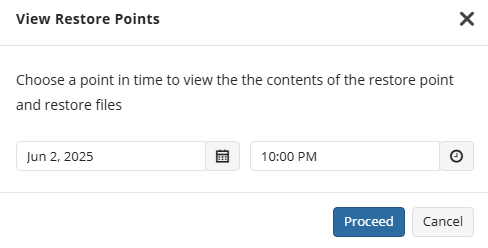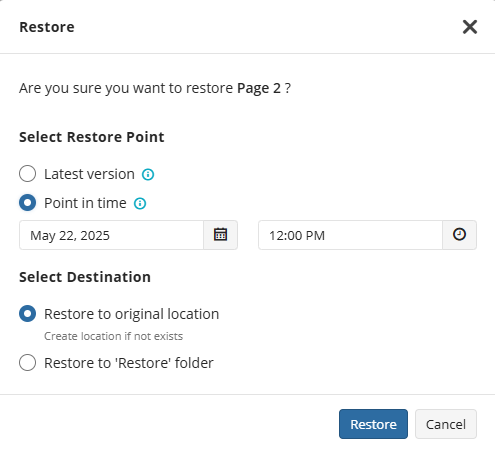Back Up Shared Drives
A separate SharePoint/Teams/Shared Drives license is required for every backed up domain to perform Shared Drives backup. Shared Drives Backup should be performed by Super Administrators of the domain who have access to the Shared Drives they intend to back up and restore.
The required permissions for proper functionality are Read and Write access.
To learn more about licensing, refer to the Licensing chapter
To back up Shared Drives:
- Assign a SharePoint/Teams/Shared Drives license for a domain in Management Console on the M365/Google Workspace > Domains by editing required domain.

- To enable Shared Drives backup, click Configure Backup on the dashboard, then turn on Shared Drives backup services. Select Apply to enabled users to create Shared Drives backup for all enabled users. To create the initial backup, click Save. The backup task is created and will be scheduled automatically. Once the initial backup is completed, you can view a list of backed up items.

The Management Console administrator must have at least the Contributor role in Shared Drives to perform backups. Global Admin Access must be granted on the Permissions tab in Organization > Administrators to access the backup content. With Global Admin access disabled, backup content cannot be viewed, item-level restore is not available.
The Management Console administrator must have at least the Contributor role in Shared Drives to perform backups.
Once these steps are complete, the Shared Drive will be available for backup.
Shared Drives backup is performed twice per day automatically.
Browse Backup Content
Administrators with Global Admin Access enabled can browse backup content to restore required content items for all domain users with enabled backup. Users if enabled can browse their own backups.

Select Restore Point
By default, the latest backup for the current date is shown. Starting with version 4.7, you can browse earlier restore points.

To view backups from another date:
- Click View Restore points on the horizontal menu.
- Select a date to switch to that restore point.

- You will be switched to the selected restore point. You’ll now see folders and documents (including earlier revisions) as they existed at the selected time and can perform restore operations for them.

Deletion is not supported in restore point view. To delete data, return to the current date
- To return to the latest backup, click Return to current date in the restore point banner.

Use Search
To find a file or folder, enter the full or partial filename and click the search icon. If a file was renamed, only the name relevant to the selected restore point will be searchable. Older names may still appear in file revisions, but can’t be searched directly. Type search expression and click the search icon to proceed. The search result appears in the right panel.

Restore Shared Drives
To restore Shared Drives objects (files and folders), select Shared Drives in the horizontal menu bar. Refer to the Prerequisites for Restore Operations chapter to avoid any issues.
You can find a necessary file by filename or part of the filename. Type the search expression and click the search icon. After the search is complete, click the file to quickly navigate to the file location. Refer to the Prerequisites for Restore Operations chapter to avoid any issues.
To restore all Shared Drives content, perform the following:
- Open the Shared Drives tab.
- Click Restore All
- Select a Restore Point. Choose one of the following options to proceed with restoring your files and folders:
- Latest version. Restore the most recent version of your files and folders.
- Point in Time. Restore files and folders to their exact state as of a specific date and time.

- If any items were renamed, they will be restored using the names that were current at the selected point in time.
- Consider, if any of the selected objects has no revisions after this point of time (was changed before this point of time), this object will not be restored.
- If the selected object exists in the selected location, the restored copy will be saved with a suffix such as "restored_'timestamp'".
- Select restore destination. By default, restore will be performed for the original location for the selected account (if some folder does not exist, it will be created). If the selected object exists in the original location, the restored copy will be saved with a suffix such as "restored_'timestamp'". In case you select restore for another account you will be prompted to provide this account credentials.
- Click Restore to create a restore job. If you have enough permissions, the Shared Drives content will be restored to the selected location. In case of insufficient permissions, this will ne reported. To view the progress of the restore job created, open the Task Manager. Click the Task Manager icon to the right of the horizontal menu bar.
Restore Specific Folder
To restore a specific folder including all subfolders and content, select the required folder.
- Click Restore.
- Select a Restore Point. Choose one of the following options to proceed with restoring your files and folders:
- Latest version. Restore the most recent version of your files and folders.
- Point in Time. Restore files and folders to their exact state as of a specific date and time.
